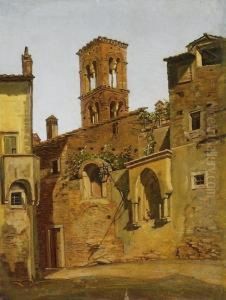Johann Carl Smirsch Paintings
Johann Carl Smirsch was a German architect and painter, born in 1793 in Bayreuth, Bavaria. His contributions to architecture and art, especially within the confines of his native Germany, were significant during the 19th century. Smirsch's work is characterized by its adherence to neoclassicism, a style that sought to revive the principles of classical Greek and Roman art and architecture. This period was marked by a keen interest in the ancient world, which influenced various artistic disciplines across Europe.
Smirsch received his education in the arts at a time when neoclassicism was at its zenith. His training would have included rigorous studies of the ancient classics, alongside the contemporary interpretations of these styles by leading artists and architects of his day. Throughout his career, Smirsch dedicated himself to the pursuit of architectural projects that reflected his deep appreciation for classical symmetry, proportions, and a harmonious blend of form and function. His architectural works, though not as widely recognized today as those of some of his contemporaries, contributed to the landscape of 19th-century German architecture with their elegance and adherence to classicist ideals.
In addition to his architectural endeavors, Smirsch was also a proficient painter, often focusing on architectural fantasies and landscapes that echoed his professional interests. These paintings, characterized by their meticulous detail and the romantic quality of their subject matter, provide insight into Smirsch's artistic vision. They bridge his architectural knowledge with his creative expression, offering a picturesque view of idealized landscapes and structures that could have been inspired by his architectural projects or by the broader neoclassical movement.
Throughout his lifetime, Johann Carl Smirsch was part of a broader community of artists and architects who were striving to define their era through a re-engagement with the classical past. His contributions, though perhaps overshadowed by more prominent figures in art history, remain a testament to the enduring appeal of neoclassicism and its principles. Smirsch passed away in 1869, leaving behind a body of work that continues to be studied by those interested in the architectural and artistic movements of the 19th century. His legacy is that of an artist who devoted his life to the pursuit of beauty, drawing inspiration from the past to inform his creations.


